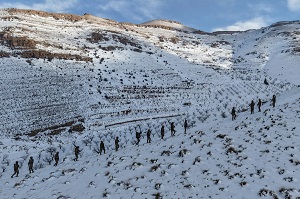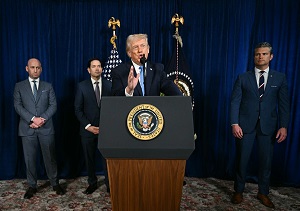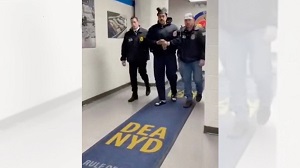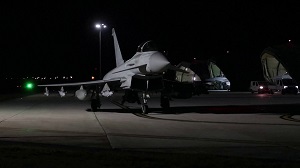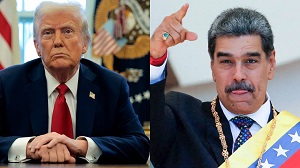Can Russia Revive the Adana Agreement between Syria and Turkey? - By brahim Hamidi, Asharq Al-Awsat
Whenever Turkey threatens to launch a military operation in northern Syria to establish a “safe zone,” Russia puts on the mediation table the revival of the Sochi Agreement on the east of the Euphrates, in preparation for the implementation of the Adana Agreement. The latter was signed by Ankara and Damascus  in July 1998, establishing security cooperation between the two parties and allowing the Turkish army to pursue the Kurdistan Workers Party (PKK) deep into Syrian territory.
in July 1998, establishing security cooperation between the two parties and allowing the Turkish army to pursue the Kurdistan Workers Party (PKK) deep into Syrian territory.
 in July 1998, establishing security cooperation between the two parties and allowing the Turkish army to pursue the Kurdistan Workers Party (PKK) deep into Syrian territory.
in July 1998, establishing security cooperation between the two parties and allowing the Turkish army to pursue the Kurdistan Workers Party (PKK) deep into Syrian territory.Since the Russian war in Ukraine, Turkish President Recep Tayyip Erdogan has activated his old plan to establish a safe zone with a depth of 35 kilometers, trying to benefit from the improvement of Ankara’s negotiating position due to Washington and Moscow’s “need” for Turkey’s role.
America clearly announced its rejection of the military operation east of the Euphrates, while Moscow mediated between Damascus, Ankara and the Kurds, and deployed Syrian army forces in various areas in the north of the country to “deter” the Turkish army, ahead of the Russian-Turkish-Iranian summit in Tehran on Tuesday.
Ankara wants new incursions linking its military “enclaves” in northern Syria, namely the Euphrates Shield, north of Aleppo, which was established in 2016, the Olive Branch in Afrin in 2018, the Peace Spring, eEast of the Euphrates, formed at the end of 2019, and the Peace Shield, at the start of 2020.
Moscow proposes either activating the Adana Agreement or the full implementation of the Sochi Agreement of 2019, in addition to a military memorandum between Damascus and Qamishli in exchange for an agreement between Ankara and Washington. Below is a review of the most important agreements:
What are the terms of the Adana Agreement?
After Turkey threatened to attack Syria in mid-1998, late Egyptian President Hosni Mubarak mediated between the two parties, until a security agreement was concluded between Ankara and Damascus in the Turkish city of Adana. The text of the agreement and its annexes included, among others, the following items:
- As of now, the leader of the Kurdistan Workers’ Party, Abdullah Ocalan (detained in Turkey since the beginning of 1999), will not be in Syria, and will certainly not be allowed to enter Syria.
- PKK members abroad will not be allowed to enter Syria.
- As of now, PKK camps will not operate on Syrian soil, and will certainly not be allowed to become active.
- Many members of the PKK were arrested and referred to the court. The lists containing their names were prepared and submitted by Syria to the Turkish side.
- Syria, based on the principle of reciprocity, will not allow any activity launched from its territory that harms the security and stability of Turkey. Nor will Syria allow the supply of weapons, logistical materials, and financial and promotional support for PKK activities on its soil.
- Syria has classified the PKK as a terrorist organization, and has banned the activities of the party and its affiliated organizations on its territory, along with other terrorist organizations.
- Syria will not allow the PKK to establish camps or other facilities for training and shelter purposes or to conduct commercial activities on its soil.
- Syria will not allow members of the Kurdistan Workers Party to use its territory to cross to third countries.
- A direct telephone line is immediately operated between the higher security authorities of the two countries.
- The two parties appoint special security representatives in their diplomatic missions in Ankara and Damascus. Those are presented to the authorities of the host country by the heads of the mission.
- Annex No.3: As of now, the two parties consider that the border disputes between them have ended, and that neither of them has any claims or rights due in the territory of the other party.
- Annex No. 4: The Syrian side understands that its failure to adopt the security measures and duties stipulated in this agreement gives Turkey the right to implement all necessary security measures inside Syrian territory to a depth of five kilometers.
What does the Adana Agreement mean at the political and security levels?
• It gives the Turkish army the right to pursue the PKK at a depth of five km in northern Syria, according to Annex No. 4.
• Damascus relinquishes any claim to its rights in Iskenderun (Hatay Province), which Turkey annexed in 1939, according to Annex No. 3.
• The PKK, led by Abdullah Ocalan, is considered a “terrorist organization”, in accordance with the provisions of the agreement.
• Ankara interprets the agreement as meaning that the Kurdish People’s Protection Units (YPG) is a “terrorist organization”, as an extension of the PKK.
• The agreement means the start of direct security contacts, knowing that the Director of Syrian National Security, Ali Mamlouk, has held several meetings with Turkish Intelligence chief Hakan Fidan.
• It also means re-operating the Turkish embassy in Damascus and the Syrian embassy in Ankara, noting that Damascus has a consulate in Istanbul, given that the agreement requires the appointment of a security liaison officer in each embassy.
• The agreement entails “indirect contacts” acknowledged by Turkish Foreign Minister Mevlut Cavusoglu, and Ankara’s recognition of the legitimacy of the Syrian government, as its required many procedures, including the formation of a joint committee and the operation of a hotline.
• The agreement offers an alternative to the Turkish-American understanding on the depth of the “buffer zone” of 32 kilometers in northeastern Syria, and opens the way for the implementation of the Sochi Agreement between Erdogan and President Vladimir Putin in October 2019, following former US President Donald Trump’s decision to withdraw his forces from the east of the Euphrates, which paved the way for a Turkish attack at the time.
What is the 2019 Sochi Agreement?
Erdogan and Putin have agreed on 10 points, including:
The determination to combat terrorism in all its forms and manifestations, and to disrupt separatist projects in Syrian territory.
• In this context, the status quo will be preserved in the current Operation Peace Spring area, which covers Tel Abyad and Ras al-Ain, at a depth of 32 kilometers.
• Both parties reaffirmed the importance of the Adana Agreement. Russia, for its part, will facilitate the implementation of this agreement under the current circumstances.
• The Russian military police and Syrian border guards will enter the Syrian side of the Syrian-Turkish border, outside the area of Operation Peace Spring, in order to facilitate the removal of the Kurdish People’s Protection Units and their weapons.
• Turkey and Russia will conduct joint patrols west and east of the Operation Peace Spring area, at a depth of 10 km, with the exception of the city of Qamishli.
• All members of the Kurdish People’s Protection Units and their weapons will be removed from Manbij and Tal Rifaat.
What about the US-Turkish agreement of 2019?
Prior to that, an agreement was signed between Erdogan and former US Vice President Mike Pence in October 2019, which consisted 13 items. Those included, among others:
• The United States and Turkey confirm their relationship as NATO partners, and the United States understands Turkey’s legitimate security concerns on its southern border.
• The two sides agreed on the need to maintain the safety of the area, in order to address Turkey’s national security concerns and seize heavy weapons from the Kurdish People’s Protection Units.
• The Turkish side temporarily stops Operation Peace Spring to allow the withdrawal of the People’s Protection Units from the Spring area. Operation Peace Spring will be halted upon completion of this withdrawal.
• Once Operation Peace Spring is stopped, the United States agrees not to continue imposing sanctions pursuant to the October 14, 2019 Executive Order banning property and suspending entry to certain persons contributing to the situation in Syria.
How did the Syrian army return to the east of the Euphrates?
In parallel with these Russian-Turkish-American agreements that followed Trump’s withdrawal from Turkey’s borders in northeastern Syria - which opened the way for Ankara’s incursion – a memorandum of understanding was reached between the Syrian Democratic Forces, the allies of Washington, and Damascus. Here are some of its points:
• The Syrian Democratic Forces (SDF), which includes the Kurdish People’s Protection Units, agreed to enter the Syrian Arab Army and extend its control over the entire region, starting from Ain Diwar in the east, and up to Jarablus in the west, where the forces will be deployed from three axes:
1. Tabqa axis in the north towards Ain Issa and its countryside, and in the north, towards the Syrian-Turkish border at Tal Abyad and towards the west.
2. The Manbij axis towards Ain al-Arab on the Syrian-Turkish border, to the point of Tal Abyad and towards the west.
3. Al-Hasakah-Tal Tamer axis to Ras al-Ain and from it to the east to Qamishli and then to al-Malikiyah and towards the south.
4. The forces are deployed in the Manbij area, starting from Arima and along the Sajour River line, according to the previous agreement on the deployment of forces in Arima.
In this memorandum, “the (SDF) forces affirmed their readiness to preserve the unity and territorial integrity of the Syrian Arab Republic and under the flag of the Syrian Arab Republic, and to stand by the Syrian Arab Army in the face of Turkish threats to the Syrian territories, led by President Bashar al-Assad.”
However, Trump’s keeping his forces east of the Euphrates has led to the slow implementation of this memorandum. In the face of recent Turkish threats, Russia returned to push the SDF and Damascus to implement the 2019 memorandum.
Just as Russia implemented the “disengagement” agreement between Syria and Israel and deployed international forces in the Golan, it seeks to put the interim agreements into effect, leading to the reactivation of the Adana Agreement, which would pave the way for “legitimizing” the government and expanding its sovereignty in the country.
Russia had previously suggested this option during the preparations for the tripartite summit in Tehran, and will continue to push for its implementation.
